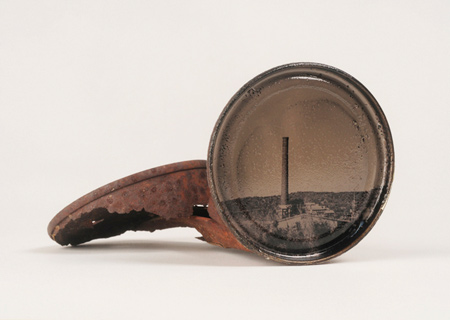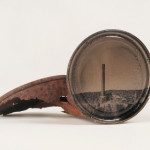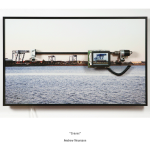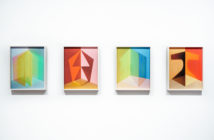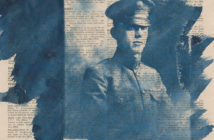 Liz Lee, Sun Prints
Liz Lee, Sun Prints
Image Courtesy of the Artist
A show of alternative-process photos could be anything these days -- from the historic analog (chemical) processes to non-standard digital manipulations to printing on atypical materials, and beyond. The PRC's "Unconventional Inventions: Innovative, Unusual, and Alternative Approaches to Photography," on view through April 16 at Endicott College in Beverly, showcases seven artists working across the spectrum of alternative processes and presentations.
Much of this work -- like much traditional alt process work in general -- feels nostalgic or ethereal. In her "photo quilts" and photographic mixed media pieces, Jessica Burko combines photo prints with discarded materials (pieces of wallpaper, illustrations from books, dressmaking patterns) to create collages that seem steeped in memory. Other works in the show, by Donna Hamil Talman, Liz Lee, and Angelina Kidd, also evoke a sense of fading memory, or of dreams or imaginings, achieved in part by layering or blurring image over image into image. Talman and Kidd create dense visual textures on smooth picture planes, while Lee stacks dye transfers over van Dyke prints to create instant relics that are wrinkled, yellowed and peeling, and sealed off beneath layers of varnish.
David Emitt Adams makes images in and around the Arizona desert, and uses wet-plate collodion process to print them onto badly rusted cans scavenged from the same area. Both the images and the objects they're printed on are connected to a specific place, and work oddly well together to tell stories about the land. Something about the diminutive size of these images messes with your brain. Maybe it's that they're images of large or expansive subjects (views of the western landscape, a plane in the sky, a long view of a factory smokestack), reduced to palm-size prints; maybe it's the fact that a photo this small is generally meant to be cradled in the hands like a treasure, yet these, being printed on cans rusted to crumbling, now rendered as sculpture, neither invite nor allow human touch.
Andrew Neumann's uniquely-constructed pieces combine still photos and video in a way that -- again -- suggests memory as a theme, but not the nostalgic sort. Here the mind goes more to surveillance and the impulse to verify memories which, like still photographs, tell only a small part of any story, and a part that's stuck in one moment in time.
From small, studied moments to the 30,000-ft view: the two large prints from Christoph Engel's Superficies series appear to be aerial photos showing scenes of radical human impact on the earth's surface.
But what, you might wonder, are aerial photos doing in a show billed as "Innovative, Unusual, and Alternative Approaches to Photography"? Valid question, and I didn't see anything anywhere in the exhibit space that explained how these images are made. I know there's a long-standing tension around this topic -- many artists and curators are loath to focus on process, technique, or the "story" behind the artwork, while most people without an art background viewing certain types of work will go immediately to those very things. And, granted, just putting the work out there without explanation does privilege content over process, and helps keep viewers focused on their own responses to the work instead of the artist's reasons for making it. I can come down on either side of this divide, depending on the work, but generally speaking, if the artist's physical process offers the viewer a "way in" to work they may not otherwise think about for more than a second, I'm all for talking about it.
In the case of Superficies, I think the absence of information about how these images are made does everyone -- and photography itself -- a disservice, so I'm going to tell you that Engel makes them by collaging together hundreds of Google Earth images in Photoshop. Google Earth is itself an enormous composite of billions of images taken at different times and in different conditions. So, right off the bat, the questions fly: are Engel's images documenting places, or inventing them? If the latter, do the photos still hold up as commentary on our use of the land? Are they intended as commentary on our use of the land? If they're "only" beautiful abstractions of real places, are they less compelling? Are these even photos/is this photography? Is Engel the 'photographer' or is his role more that of editor or collagist or curator?
Any of these questions can start spirited discussions about the nature of photography and the implications of certain current trends within it. It's too bad most people visiting the exhibit are likely to view Engel's images as straight-up aerial photos, unaware of the delicious provocations staring them in the face.
- David Emitt Adams, Smelter, Tintype on found object from the Sonoran Desert, 2012. Image Courtesy of the Artist
- Liz Lee, Sun Prints Image Courtesy of the Artist
- Andrew Neumann, Cranes, Archival Pigment Print, LCD Screen, Motor, Misc. electronics, 2007 Image Courtesy of the Artist
The Photographic Resource Center's
Unconventional Inventions: Innovative, Unusual, and Alternative Approaches to Photography is on view through April 16 at Endicott College's Carol Grillo Gallery in the
Walter J. Manninen Center for the Arts, 376 Hale Street, Beverly, MA 01915

